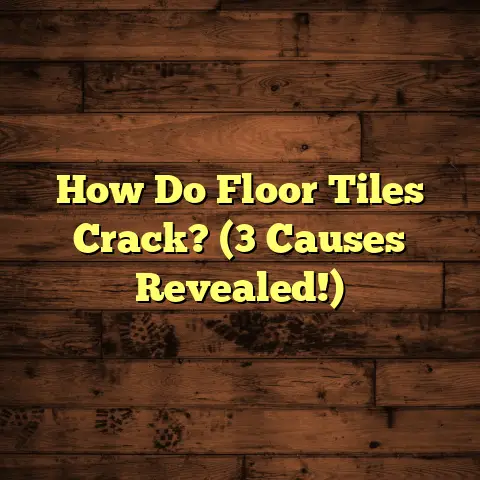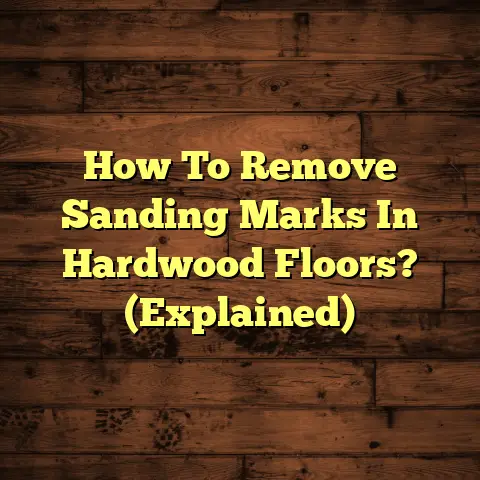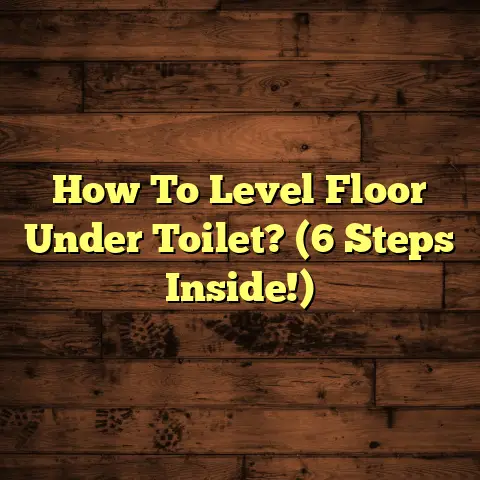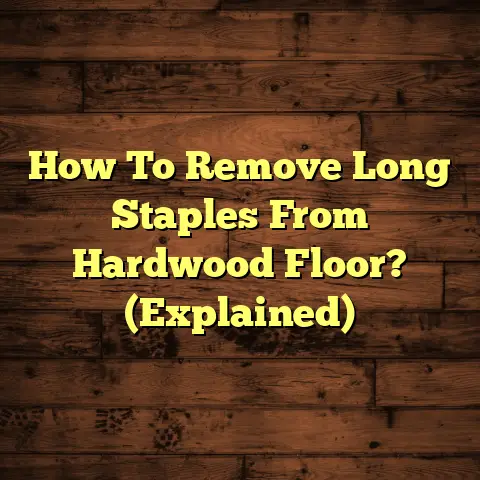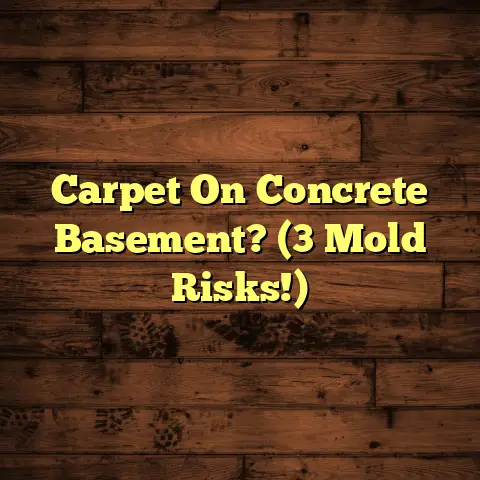Epoxy on Wood Floors: Good Idea? (4 Finish Flaws!)
Have you ever envisioned transforming your traditional wood floors into a stunning, glossy masterpiece that withstands the test of time?
I know I have!
As a flooring contractor, I’ve seen some incredible transformations.
But is epoxy the magic bullet for wood floors?
Let’s dive in, shall we?
We’ll explore the shiny world of epoxy on wood, the good, the bad, and the downright ugly.
Understanding Epoxy as a Flooring Material
So, what exactly is epoxy?
Think of it as a super-strong, two-part adhesive.
It’s made of a resin and a hardener.
When you mix them, a chemical reaction happens, creating a rigid, durable plastic.
This stuff is seriously tough!
Epoxy’s popularity is soaring, and I’m seeing it everywhere.
From garage floors to countertops, and now, even wood floors.
Why the hype? Well, epoxy boasts impressive properties:
- Durability: Resists scratches, impacts, and wear.
- Water Resistance: Creates a seamless, waterproof barrier.
- Ease of Maintenance: Simple to clean and maintain.
- Versatility: Can be tinted, colored, and customized.
These features make it an appealing option for homeowners and designers alike.
The Process of Applying Epoxy on Wood Floors
Alright, let’s get practical. How do you actually put epoxy on wood floors?
It’s not as simple as slapping on a coat of paint, trust me.
Here’s a step-by-step breakdown:
Preparation is Key: This is the most crucial step.
You need to clean the floors thoroughly, removing any dirt, grime, or old finishes.Sanding: Sand the wood floors to create a smooth, even surface and to help the epoxy adhere properly.
I usually start with a coarse grit (60-80) and work my way up to a finer grit (100-120).-
Priming: Apply a primer specifically designed for epoxy to ensure proper adhesion and prevent air bubbles.
Mixing the Epoxy: Carefully mix the resin and hardener according to the manufacturer’s instructions.
Get the ratio wrong, and you’re in trouble!Application: Pour the epoxy onto the floor and spread it evenly using a squeegee or notched trowel.
Work in small sections to avoid the epoxy setting too quickly.Bubble Removal: Use a propane torch or heat gun to remove any air bubbles that may have formed during application.
Be careful not to overheat the epoxy!Curing: Allow the epoxy to cure completely according to the manufacturer’s instructions.
This can take anywhere from 24 to 72 hours.
Important Tools and Materials:
- Floor sander
- Vacuum cleaner
- Epoxy primer
- Epoxy resin and hardener
- Mixing buckets
- Squeegee or notched trowel
- Propane torch or heat gun
- Safety glasses
- Gloves
- Respirator
Safety First!
Epoxy fumes can be harmful, so always wear a respirator and work in a well-ventilated area.
The Benefits of Epoxy on Wood Floors
Okay, so why would you even consider epoxy for your wood floors?
Let’s talk about the perks!
Enhanced Aesthetics: Epoxy can transform dull, worn-out wood floors into a sleek, modern masterpiece.
The high-gloss finish reflects light beautifully, creating a bright and airy space.Increased Durability: Epoxy is incredibly tough and resistant to scratches, impacts, and wear.
It’s a great option for high-traffic areas.Improved Resistance to Damage: Epoxy is waterproof and resistant to chemicals, stains, and spills.
It’s perfect for kitchens, bathrooms, and other areas prone to moisture.-
Design Versatility: You can tint epoxy to any color you desire, add metallic pigments for a shimmering effect, or even embed objects like coins or seashells for a truly unique look.
I’ve seen some amazing transformations.
One homeowner I worked with had dull, scratched-up oak floors.
We applied a clear epoxy coating, and the difference was night and day!
The floors looked brand new, and they were incredibly easy to clean.
The 4 Finish Flaws of Epoxy on Wood Floors
Now, let’s get real. Epoxy isn’t perfect.
While it offers numerous benefits, it’s crucial to recognize its potential drawbacks.
I’ve seen these issues firsthand, and they can be a real headache.
Here are four finish flaws you need to be aware of:
1. Cracking and Peeling
This is a big one.
I’ve seen it happen when the epoxy isn’t applied correctly or when the wood wasn’t properly prepared.
Why does it happen?
- Improper Application: If the epoxy is mixed incorrectly, applied too thinly, or applied to a dirty or uneven surface, it can crack or peel.
- Environmental Factors: Extreme temperature changes or humidity can also cause epoxy to crack or peel.
Wood expands and contracts with temperature and humidity, and if the epoxy can’t flex with it, it can crack. - Subfloor Issues: A weak or unstable subfloor can also cause the epoxy to crack.
If the subfloor is moving or flexing, it will put stress on the epoxy coating.
How to prevent it:
- Follow the manufacturer’s instructions carefully when mixing and applying the epoxy.
- Ensure the wood floors are clean, dry, and properly sanded before applying the epoxy.
- Use a high-quality epoxy primer to improve adhesion.
- Control the temperature and humidity in the room during application and curing.
2. Yellowing Over Time
This is another common issue, especially with clear epoxy coatings.
Why does it happen?
- UV Exposure: Exposure to ultraviolet (UV) light from the sun can cause epoxy to yellow over time.
This is because the UV light breaks down the chemical bonds in the epoxy, causing it to change color.
How to prevent it:
- Use an epoxy that is specifically formulated to be UV resistant.
- Apply a UV-resistant topcoat to protect the epoxy from sunlight.
- Use curtains or blinds to block direct sunlight.
I’ve seen beautiful, clear epoxy floors turn an unsightly yellow within a year or two.
It’s a real bummer.
3. Difficult Repairs
If your epoxy floor gets damaged, repairing it can be a real pain.
Why is it difficult?
- Seamless Finish: Epoxy is designed to create a seamless finish, which means that any repairs will be noticeable.
- Adhesion Issues: It can be difficult to get new epoxy to bond properly to old epoxy.
- Complete Removal: In some cases, the only way to repair a damaged epoxy floor is to remove the entire coating and start over.
How to minimize the need for repairs:
- Use a high-quality epoxy that is resistant to scratches and impacts.
- Protect the floor from heavy objects and sharp edges.
- Clean up spills immediately to prevent staining.
One client of mine dropped a heavy cast-iron skillet on her epoxy floor, creating a large crack.
The repair was visible, and she ended up redoing the entire floor.
4. Limited Breathability
Wood needs to breathe. Epoxy, unfortunately, doesn’t let it.
Why is this a problem?
- Moisture Trapping: Epoxy creates a waterproof barrier, which can trap moisture in the wood.
- Warping and Mold Growth: If moisture gets trapped under the epoxy, it can cause the wood to warp, rot, or develop mold.
How to mitigate this issue:
- Ensure the wood floors are completely dry before applying the epoxy.
- Use a moisture meter to check the moisture content of the wood.
- Consider using a breathable epoxy primer.
- Properly ventilate the room to prevent moisture buildup.
I once had a client who applied epoxy to their basement wood floors without properly addressing a moisture issue.
Within months, the floors were warped and covered in mold.
It was a disaster!
Real-Life Experiences and Common Questions
Let’s hear from others who have taken the plunge.
“I love the look of my epoxy floors,” says Sarah, a homeowner in California.
“They’re so easy to clean, and they really brighten up my living room.
But I did notice some yellowing in the areas that get a lot of sunlight.”
John, a contractor in New York, shares, “Epoxy can be a great option for wood floors, but it’s not for everyone.
It requires careful preparation and application, and it’s not always easy to repair.”
Here are some common questions I get asked:
How much does it cost to epoxy wood floors? The cost can vary depending on the size of the area, the type of epoxy used, and whether you hire a professional or do it yourself.
Expect to pay anywhere from \$5 to \$15 per square foot.Can I apply epoxy over existing wood finishes? It’s not recommended.
Existing finishes can prevent the epoxy from bonding properly.
You’ll need to sand the floors down to bare wood first.-
How long does epoxy last on wood floors? With proper application and maintenance, epoxy can last for 10-20 years.
Is epoxy slippery? Epoxy can be slippery, especially when wet.
You can add a non-slip additive to the epoxy to improve traction.
Conclusion
So, back to our original question: Is epoxy on wood floors a good idea?
Well, it depends.
If you’re looking for a durable, waterproof, and aesthetically pleasing flooring option, epoxy might be worth considering.
However, it’s crucial to weigh the benefits against the potential drawbacks, such as cracking, yellowing, difficult repairs, and limited breathability.
Ultimately, the decision is yours.
Do your research, weigh the pros and cons, and consider your specific needs and circumstances.
And hey, if you’re still unsure, give me a call.
I’m always happy to share my expertise and help you make the best choice for your home.
Now, go forth and create the floors of your dreams!
Just remember to do it wisely.
